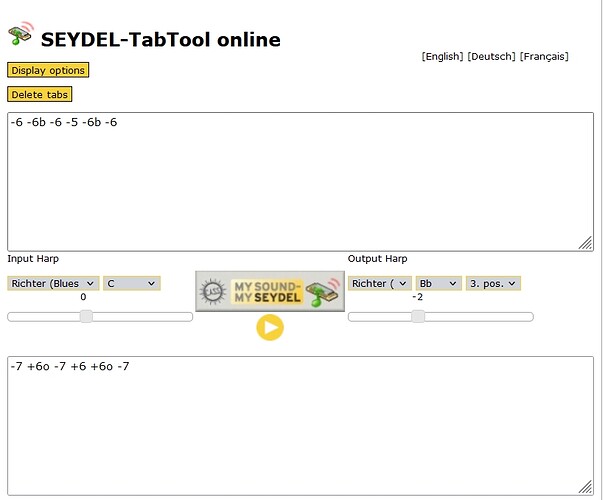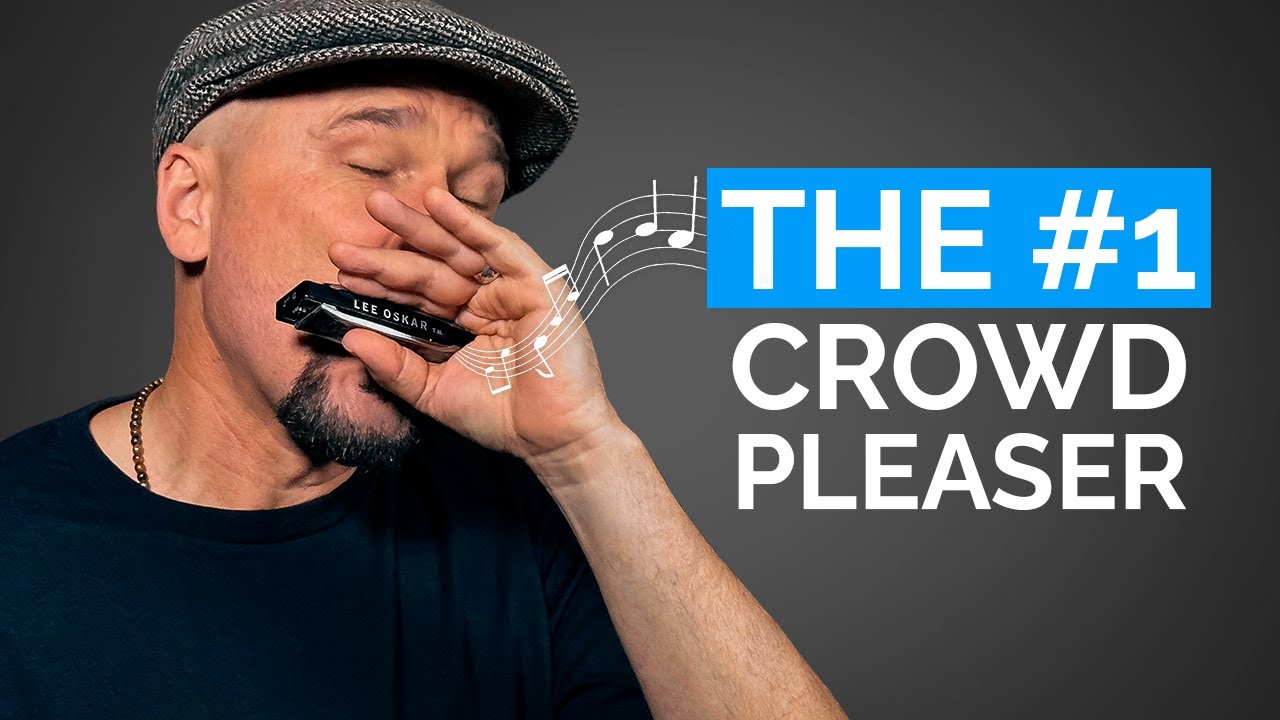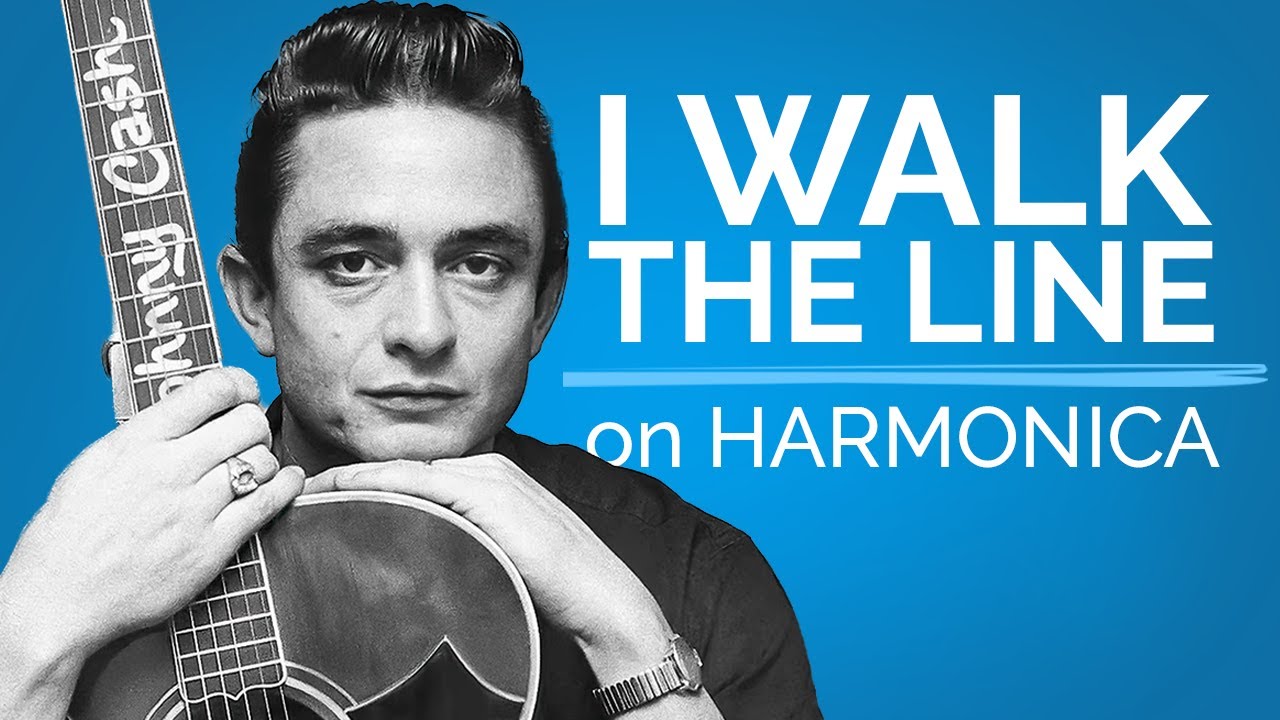Yeah man consider re-visiting Module 3 Lessons 31-40 for review of 3rd position scale and melodies. Such a great position. Links to lesson and other scale links to lessons in this post:
Seydel have a great page on there site to help us figure positions.
They also have tab tool to reconfigure tabs to different positions
Cool. Weird though, there’s an error. It says 5th position on an A harmonica is Dbm, when in actuality it’s Cm. ![]()
Hi Luke @Luke
No, 5th position on an A harp is Db/C# because it is the 3rd note of the A major scale (or equivalently: C# is 4 half-steps above A). I play 5th position really frequently (but not much on an A harp because C# is not so common among the songs I play – and my fellow musicians don’t seem to play anything in C# minor).
Regards,
– Slim ![]()
Oh yeah, duh. The major 3rd of A is C#. Hello Luke. Thanks for the correction Slim!
It’s not a perfect tool but works well for some things not others. I don’t know enough about music theory to tell the difference.
#Dai
Excellent tools. I was working on this manually., Making a graphic blues scale chart for each position.
Luke
There are four different sets of Amazing grace I found online. Is this an example of first and other positions?
Yes I believe I teach them all here? Did you already see this?
Also do 4 positions on this one I think?
Jon Gidnick an old British player has an excellent book out showing the various positions and how to use them and some songs. Even the 12th position.
So how many harmonicas is a “full range?” Right now, I have a C, G, A, D. I don’t play with a band. But I do like to try to jam with Spotify. Sometimes, I’m able to play in key swapping around the above harmonicas and then swapping positions. But I think the above array still misses flat and sharp keys, e.g. Bb, F# (Eb I guess is 7th position on an A harmonica - not sure how to translate that) So…I’m guessing that means I need more harmonicas if I want to do that? Or maybe I unnecessarily bought harmonicas I don’t need (anlthough I like the sound of the G and the A a lot, so in that sense they were were worth it) And If I want to play a song using Bb blues on the piano then I need to get an Eb harmonica?
@jeevanmd Welcome to the forum! Yes, you are correct you’d need and Eb harmonica to play blues in Bb. Similarly, you’d need an Ab harmonic to play.
There are 12 keys so to have a full set you need 12.
B is a pretty rare key, so you can probably put off F#.
Traditionally your G harmonica is the lowest key, and (because F# is rarely played) F is the highest (commonly played) key. F is very often used in country and gospel stuff, as well as blues. Because it’s so high it cuts through the mix easily, but you also might find it a little shrill sometimes, in which case picking up a Low F is worth considering, which by contrast is mellower tone (but harder to cut through the mix and requires more effort to bend notes.)
So the next keys you probably wanna consider picking up are:
Bb - plays blues in F
F - plays blues in C
Ab - plays blues in Eb
Eb - plays blues in Bb
(Of those Bb and Ab are in the lower range, and Eb and F are in the higher range.)
Hope that helps!
So, I got overblows semi reliable today!! I noticed that those notes aren’t in the bend it better tool and so I’ve been picking other keys to see how in tune I am. If I get my overblows super reliable then between bending and overblowing I can play chromatically on any harmonica, correct? In which case, I don’t have to pick keys, I just have to pick the tonal quality of the harmonica to play in tune with any song that comes on the speakers?
And overbends don’t necessarily get me other actual notes correct? They are more an effect to get 1/4 tones etc?
@jeevanmd I’m gonna try and keep my reply here on topic for the thread which is harmonica positions. If you wanna talk more about the details of OB/OD technique, please choose an existing thread on the topic, or create a new one.
But overblows and overdraws DO relate to positions because POSITIONS indicate our root note, BUT NOT the quality of tonality we are playing.
For example, when we think 1st position, we think major tonality like folk music, but you CAN play blues in 1st position (it just requires playing overblows on 1, 4, and 6, and overdraw on 5 as Howard Levy exemplifies in Slow Blues in C.)
I could provide a million other examples, but hopefully this is enough to illustrate the point.
Incorrect. Overblows and overdraws are actual notes that are otherwise missing from a diatonic harmonica.
Incorrect. Each position still lends itself naturally to certain tonalities. For example, let’s say you can play a decent 2nd position blues right now. I just said you CAN play blues in 1st position. Well Howard can, at least. You could go and practice 1st position blues for the next 10 years and still not have it sound as bluesy and sweet and effortless as your 2nd position blues sounds RIGHT NOW!
The way each position lays out lends itself to naturally sound great in certain contexts. That’s why all professional diatonic harmonica players own AT LEAST 12 harmonicas, and most own many more! (Even Howard Levy.)
Hope that helps! ![]()
@Luke thank you so much for taking the time for such a detailed answer. It was SOOO helpful in a multitude of ways.
In the harmonica course we solidly learn up to 4th position. The position AND the harmonica key inform tonality. Therefore, playing in 3rd position on a C harmonica would be a more minor feel whereas playing 1st position on an A harmonica would have that major feel. I could get to A major with overblows etc on the C harmonica but given the ease of playing first position on an A harmonica, it would make less sense to kill myself with those advanced techniques but rather just get the right key harmonica.
And then how do I determine what key harmonica/position I need if I just want to jam along with a track on the speakers?
Need is not appropriate here since for playing in almost any key you can use almost any harp! It all depends on your skill level and what sort of “feeling” you wish to express.
An example: when the track is in a minor key, let’s say E minor, you could play that with a variety of blues harps: B harp in 2nd position, D harp in 3rd position, G harp in 4th position, C harp in 5th position, … There is no need to use any particular one of these, unless you perhaps only have one of these in your collection of harps, or perhaps you can only play blues harp in just one position.
Determining in which key the track is being played and whether that key is major or minor is perhaps what you are asking?? If so, there are already answers in this forum’s database. You just use the Search function and spend some of your time and effort finding them.
Regards,
– Slim ![]()
Thanks for all the insights. And Sorry to have belabored the point. I’ll definitely search for those other answers.
I am a beginner player with a piano background. Only interested in playing melodies on solo tuned harps and reading from standard sheet music. I am having difficulty understanding positions. I have read all of the above. I have watched your video " Harmonica Keys for Beginners (+ Learn a Muddy Waters Riff)" and explanations on various other websites, yet I am still confused.
Nobody provides actual examples using tabs to explain what it all means. Whilst I don’t use tabs, they are an unambiguous way of explaining which holes to use, for dummies like me.
So let’s look at the Beatles song “Hey Jude” in the key of C. It has all notes ranging from B3 up to D5, but if we shift it up an octave it can be played on holes 3-draw up to 8-draw on a C diatonic harp with no bends or overblows. (Those notes are in holes 4-draw up to 9-draw on a C solo-tuned harp which I use).
The tabs for the first 4 lines in the key of C on a diatonic C harp, first position (minus the slurs) are as follows:
6 5 5 6 -6 -4
Hey Jude don’t make it bad
-4 5 -5 7 7 -7 6 -6 5
Take a sad song and make it better
6 -6 -6 -6 -8 7 -7 7 -6 6
Remember to let her into your heart
4 -4 5 -6 6 -5 5 -3 4
Then you can start to make it better
So can someone please provide the tabs that would be used to play that song in “second position” (ie. in the key of G) on a C harp because I cannot see how it is possible. If you transpose the song down into the key of G then the song starts on D5, the lowest note becomes F4# and the highest note becomes A5, but you need both F4# and F5#. You can get F4# via bending but you can’t get F5# according to What Are All the Notes On a C Harmonica? – Including Bending Charts for All 12 Keys! meaning the song can’t be played in second position on a C harmonica. Or am I missing something?
Can someone also please explain why you would want to do that. If you want to play Hey Jude in the key of G then why would you not simply grab a G harp and play the exact same tabs as above, which would give you that song in the key of G with no bends or overblows. Or is it all about actually wanting to use bends so as to give a bluesy sound?
This is perhaps part of your problem, because solo tuning as a layout of the notes different than the “standard” diatonic Richter-tuned blues harps for which probably 99% of explanations concerning positions are discussing – and these do not directly translate to solo-tuned harps. ![]()
Concerning your problems with transposing “Hey Jude” it is clear that you seem to know nothing about overblows on blues harps because F5# is obtained by overblowing hole 4 (which is usually tabbed as +4o). Since overblowing is considered an advanced technique, it is almost certain that playing it is (currently) beyond your skill level. And the link you provided for all bends on a C harmonica is incomplete because it does not include the available notes that can be played using more advanced playing techniques (such as overblows and overdraws).
Why would some wish to play “Hey Jude” in G on a C Richter-tuned blues harp rather than simply grabbing a G harp and playing it, the answer is obvious and simple: if you do not have a G harp but you do have a C harp (and have mastered at least the +4o), then there you have it. Of course you could always run out and buy a G blues harp … but not everyone wishes to do that or can do that “on the spot” (for example during a gig).
It is also true that the “bluesy” bends available in one position (say 2nd position) might not exist (or require advanced techniques that the musician has not learned) in another position (for example in 1st position). And on a solo-tuned harp in the key of C I assume that you know how difficult it is to play with feeling and expression (for example) the very common “bluesy” bends of G to Gb or B to Bb (just to name a few) that are some of the easier and “essential” techniques on a Richter-tuned blues harp in the key of C when played in 2nd position? Of course, one solution would be to simply grab a solo-tuned harp in an appropriate key (if one happens to exist) that will allow such bends … rather expensive! ![]()
– Slim ![]()
The creator of this website indicates on his note charts that +4o is not achievable, as does nearly every other website that comes up if you Google “diatonic harmonica note layout”. That includes learntheharmonica.com and bluesharmonica.com. That suggests that +4o is a skill not posessed by many people.
As “Slim” says at What exactly is an overblow? - #3 by Slim : “(That) makes playing them “on stage” a hit-or-miss affair – and for this reason many professionals never or almost never use them.”
Anyone who has mastered it is definitely going to have a full set of 12 harps including a G harp, probably multiple harps in other tunings plus various mics and amps etc, so I am not sure that reasoning is valid, but I do understand the blues sound concept.
PS. I am not interested in playing in anything other than first position and only on a solo tuned or chromatic harp, not a diatonic harp. I was just interested in understanding the concept as it applies to diatonic harps.
I am not alone. I have come across quite a few posts on various websites from people like me who simply want to play melodies on a harmonica and are not interested in learning bending or any other advanced skills.


